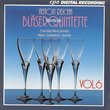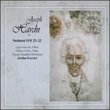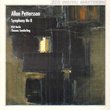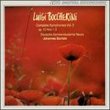| All Artists: Sofia Gubaidulina, Danish String Quartet members Title: Sofia Gubaidulina: String Quartets 1-3 / String Trio Members Wishing: 3 Total Copies: 0 Label: Cpo Records Release Date: 6/28/1994 Genres: Special Interest, Classical Style: Chamber Music Number of Discs: 1 SwapaCD Credits: 1 UPCs: 761203906420, 076120390642 |
Search - Sofia Gubaidulina, Danish String Quartet members :: Sofia Gubaidulina: String Quartets 1-3 / String Trio
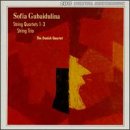 | Sofia Gubaidulina, Danish String Quartet members Sofia Gubaidulina: String Quartets 1-3 / String Trio Genres: Special Interest, Classical
|
Larger Image |
CD DetailsSimilar CDs |
CD ReviewsA solid performance of three difficult works Christopher Culver | 07/18/2005 (4 out of 5 stars) "This CPO disc contains four pieces by Sofia Gubaidulina, a Russian-Tartar composer of singularly original and individualistic music. These are her three string quartets written up to 1993, and her "String Trio". Performances are given by The Danish Quartet, the ensemble of Tim Frederiksen (violin I), Arne Balk-Moeller (violin II), Claus Myrup (viola), and Henrik Brendstrup (cello).
Sofia Gubaidulina's works for string quartet and string trio have always seemed to me to lie at the outskirts of her oeuvre, even though they contain the elements common to all her work that we have come to love. This is perhaps because of their intensity, a single-minded dedication to certain mystical principles without the variety of longer or larger works. The result is music that one doesn't come back to as often as her colourful masterpiece JOHANNES-PASSION or her CANTICLE TO THE SUN, but nonetheless of great power and profundity. Gubaidulina's "String Quartet No 1" was written in 1971, what many would consider prior to her maturity as a composer. In a work primarily about isolation, the score contains prescribed pauses during which the musicians, who had begun the work sitting together in the centre of the stage, slowly move towards the four corners of the stage. The result is that each instrumentalist plays the last six pages of the score as if a solo musician. Unfortunately, a stereo cannot fully communicate this concept, and we miss out, just as a home listener cannot see the light show accompanying some other Gubaidulina pieces. The "String Quartet No 2" was commissioned in 1987 by the Kuhmo Chamber Music Festival for the Sibelius Quartet. Sixteen years had passed since her first quartet and in that time her compositional technique had changed entirely. During the 1970s her work began to be deeply inspired by her Eastern Orthodox faith, and in the 1980s this religious inspiration was accompanied by a profound interest in "zahlenmystik", or the use of mystical mathematical formula such as the Fibonacci Sequence and Golden Ratio. This piece is related to her symphony "Stimmen ...Verstummen" of the previous year in its exhibition of musical forms which seem to be ultimately derived out of and subsequently returning into a divine silence, but whereas the symphony is centred around a D-major triad, the quartet takes as its basis a sustained G on which variations subsequently arise. In contrast to the great gap between the first and second quartets, The "String Quartet No 3" followed closely after the previous. It finds inspiration in lines from T.S. Eliot's "The Waste Land", and is a single movement work divided evenly into an opening section of plucking techniques and a latter half where the bow is introduced and the sound is drastically transformed even though the same ideas are explored. I find this the least successful of Gubaidulina's quartets, but I admit I may be misunderstanding it entirely. The "String Trio" for violin, viola, and cello (1988) was written right after the third string quartet and is tremendously exciting. The first movement begins with scratchy austerity and eventually breaks into every interplay of the strings that one can imagine. The second movement has a clockwork rhythm reminiscent of Ligeti's second string quartet, while the third, final movement summarises what came before and breaks it down into a meditative lull. I used to be critical of the Danish Quartet's performance, but better appreciate it now. The is also a performance by Yevgeniya Alikhanova, Tatyana Kokhanovskaya, and Olga Organovich on Collego. The performances here must be accompanied by those of the Arditti Quartet ("Arditti Quartet Edition 9" on the French label Montaigne). The Arditti Quartet disc has a less astringent sound, but the recording of the Danish Quartet seems to better explore the space. It is a great regret that this disc was prepared too early to include her fourth string quartet, which was written later in 1993 for the Kronos Quartet and makes fascinating use of tape and flashing lights." |

 Track Listings (6) - Disc #1
Track Listings (6) - Disc #1